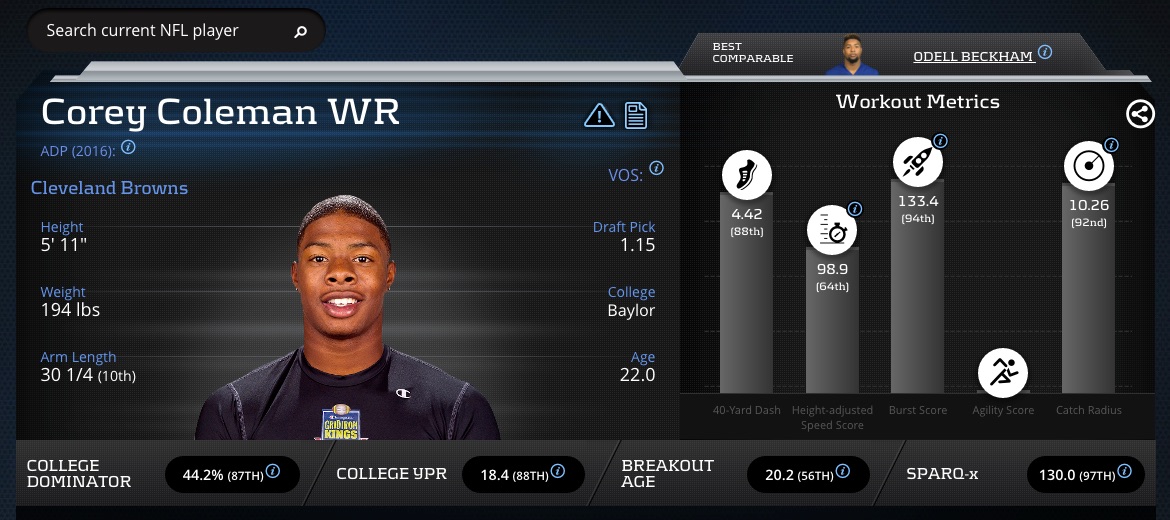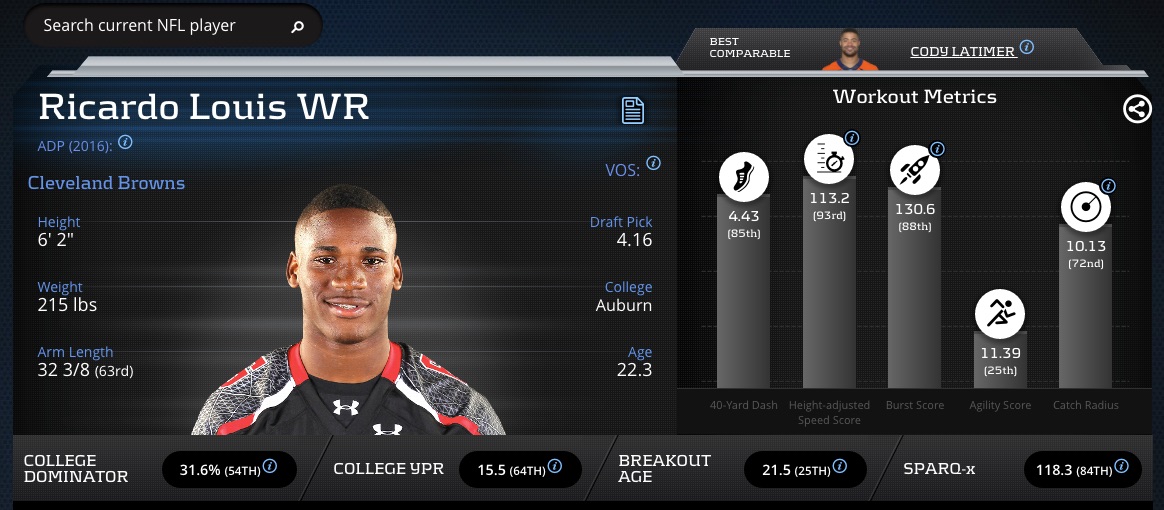In their 17th season since entering the NFL as an expansion team, the Cleveland Browns combination of porous defense, largely apathetic locker room, and fractured leadership propelled them to seemingly impossible levels of futility. Following the season, team owner Jimmy Haslam rebooted his front office and coaching staff for the third time in four years, and signed off on Hue Jackson as the Browns ninth head coach since 1999.
Jackson is a respected offensive mind, and in his second stint as an NFL head coach, he now faces the daunting task of rebuilding an offense that finished 28th in yards per play, and scored the third fewest points in the league, despite throwing the ball over 600 times last season. To get the ball rolling, Jackson brought in Robert Griffin III to supplant Josh McCown as the starting quarterback, and the Browns drafted four rookies to inject life into perhaps the worst receiving corps in the NFL.
First round pick Corey Coleman immediately steps in as Cleveland’s number one receiver. In a perfect world, Josh Gordon (who’s record-breaking four-game streak of excellence in 2013 now feels like mythology) would be the Browns number one receiver, and Coleman number two. But even if Gordon is reinstated in August, the Cleveland brass is likely to flip him for a daft pick before he can fail another urine test. It’s fairly safe to conclude that the troubled receiver will never wear the Brown and Orange again.

Corey Coleman Advanced Stats & Metrics Profile
Aside from Corey Coleman, Gary Barnidge and Duke Johnson can expect plenty of targets. Neither figures to be challenged in his role as the starting tight end and receiving back, respectively. So the real competition for playing time in the passing game begins behind Coleman at receiver. Jackson has been coaching in the NFL since 2001, and for six of those seasons he has served as either the head coach or offensive coordinator. Perhaps a close look at the three most-targeted receivers from each of those six high profile coaching stints may provide some direction for predicting who will emerge as Cleveland’s second third receivers this fall.
The Future Favors the Youth
Top-3 WR AVG: 24.9 years old
WR1 AVG: 25
WR2 AVG: 24.5
WR3 AVG: 24.8
The average age of a top three receiver from Jackson’s stops in Washington, Atlanta, Oakland and Cincinnati was 24.9 years old. Of the 18 pass catchers sampled, Brandon Tate, who was 27 when he drew 26 targets for the Bengals back in 2014, was the oldest. Laurent Robinson saw the third-most receiver targets for his team (74) as a 22-year old rookie in Atlanta in 2007. Darrius Heyward-Bey was just 23 years old when he logged the second-most receiver targets (65) for the 2010 Raiders, as was Denarius Moore (76) the following season.
With four drafted rookies in the fold, 30-year old veteran Andrew Hawkins could find himself on the roster bubble. Some analysts may point to a familiarity with Jackson from their days in Cincinnati in 2012-13, but Jackson coached the Bengals’ secondary, then running backs at the time. This offseason, the Browns have already cut ties with veterans Dwayne Bowe and Brian Hartline, and Hawkins doesn’t figure into the team’s future plans.
The Importance of Being Drafted
Top 3 WR AVG: 3rd round
WR1 AVG: 2nd
WR2 AVG: 3rd
WR3 AVG: 4th
This almost certainly isn’t unique to Hue Jackson offenses, but of the 18 receivers sampled, not one came into the league as an undrafted free agent. Chaz Schilens, who saw 34-targets for the Raiders in 2011, was a seventh round draft pick, but otherwise Moore, Marvin Jones, and Dernarian McCants were the lowest drafted players – all fifth round picks – to emerge as a top-three receiver in a Jackson offense. This year, the Browns drafted wide receivers in the first (Corey Coleman), fourth (Ricardo Louis), and fifth rounds (Jordan Payton and Rashard Higgins). These four rookies will have an edge over young holdovers Taylor Gabriel, Rannell Hall, and Darius Jennings, in part because those players were undrafted, and the current regime has very little invested in them.
Size Matters
Top 3 WR AVG: 6-2 203 pounds
WR1 AVG: 6-2 205
WR2 AVG: 6-2 209
WR3 AVG: 6-1 199
Corey Coleman checks in at just under 5-11, but the Browns have rounded up on their team roster. Only one of the 18 top-three receivers from a Jackson-coached offense – Jacoby Ford in 2010 – measured shorter than Coleman, and at 5-9, Ford was still over an inch taller than Hawkins (5-7) and Gabriel (5-8). Ricardo Louis (6-2, 215), Payton (6-1, 207), and Higgins (6-1, 196), all fall inside Jackson’s height/weight tendencies, as do undrafted rookie Dennis Parks (6-2, 201) and Hall (6-0, 198). Converted quarterback Terrelle Pryor, at 6-4 and over 230 pounds, would be a major outlier, but with barely a year of experience at the position, he’s a long shot to crack the Browns top-three at receiver.
Athletes Wanted
Top 3 WR AVG: 4.43 40YD, 36-inch vertical jump, 122-inch broad jump, 4.23 20-yard shuttle, 6.90 3-cone
WR1 AVG: 4.42, 37-inch, 123-inch, 4.25, 6.93
WR2 AVG: 4.43, 35.6-inch, 121.6-inch, 4.19, 6.85
WR3 AVG: 4.44, 36.7-inch, 122.8-inch, 4.24, 6.89
Corey Coleman never performed the shuttle drills prior to the draft, but he exceeds the expected averages for a number one receiver in terms of speed (4.40) and burst (40.5-inch vertical jump and 129-inch broad jump). Ricardo Louis exhibits below average agility compared to past Jackson receivers (4.32 shuttle, 7.07 3-cone), but he makes up for it with favorable speed (4.43 40-time) and exceptional burst (38-inch vertical jump and 132-inch broad jump). Jordan Payton‘s numbers are fairly ordinary across the board (4.47, 34.5-inch, 121-inch, 4.33 and 7.08), but they are still in the ballpark of past Jackson receiver averages.

Ricardo Louis Advanced Stats & Metrics Profile
Athleticism is where Rashard Higgins underwhelms. His 40 time (4.64) and shuttle times (4.52 20-yard and 7.19 60-yard) would be slower than any top-three targeted receiver in a Jackson offense to date. Many fantasy football analysts love Higgins’ college production, while a number of NFL Draft pundits lauded his game tape, but he lags well behind his mid-round rookie classmates in terms of size and athleticism.
2016 Outlook
Jackson’s most recent offenses in Oakland and Cincinnati have finished between 22nd and 26th in the league in pass attempts, and between fourth and seventh in rushing attempts, while still scoring above the league average. Part of his appeal is his ability to coax ball movement and points out of less-than-stellar personnel. Still, in six seasons, Jackson’s top three-most targeted receivers have produced at the following average clips:
WR1: 71 REC 1055 YDS 6 TD
WR2: 49-620-4
WR3: 27-364-2
The WR1 numbers are ambitious, but attainable, for Corey Coleman. He’d need to average about 4.5 catches for 66 yards per game. Ricardo Louis‘ size, speed and draft status make him the favorite to win the second receiver spot. Producing 620 yards may seem like a lot for a fourth round rookie, but Jackson coaxed 618 yards out of fifth rounder Moore in just 13 games in 2011. Louis would need three receptions for 39 yards per game to reach WR2 averages. Rashard Higgins has the early lead on Jordan Payton for WR3, but mainly because the latter had to sit out OTAs while he finished school at UCLA. With an edge in size and athleticism, and similar final-season college production, Payton is a good bet to see significant snaps in 2016. However, sitting under Coleman, Louis, Barnidge, and Duke Johnson on the target totem pole, it will be difficult for Cleveland’s third receiver to be a fantasy football factor this season.


